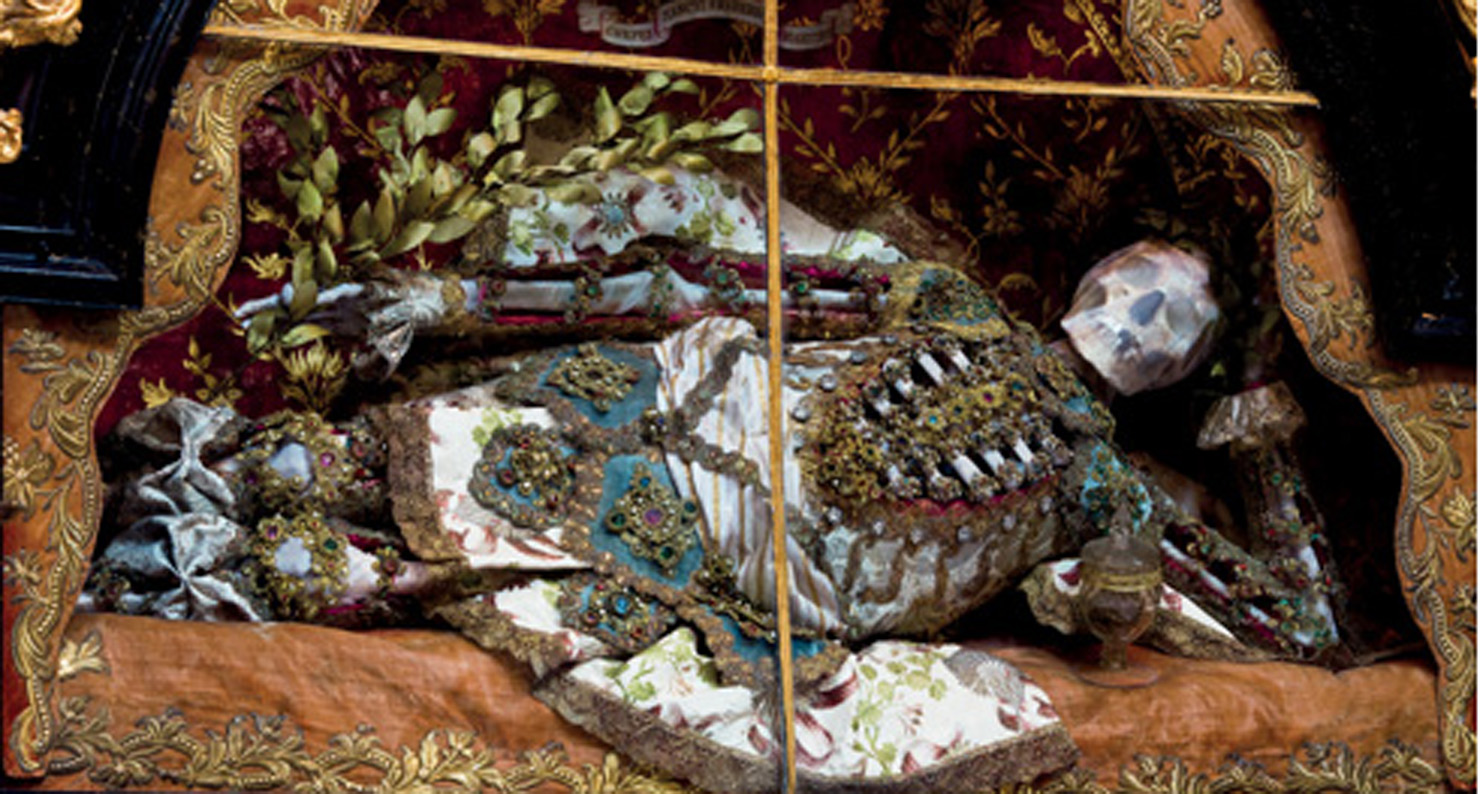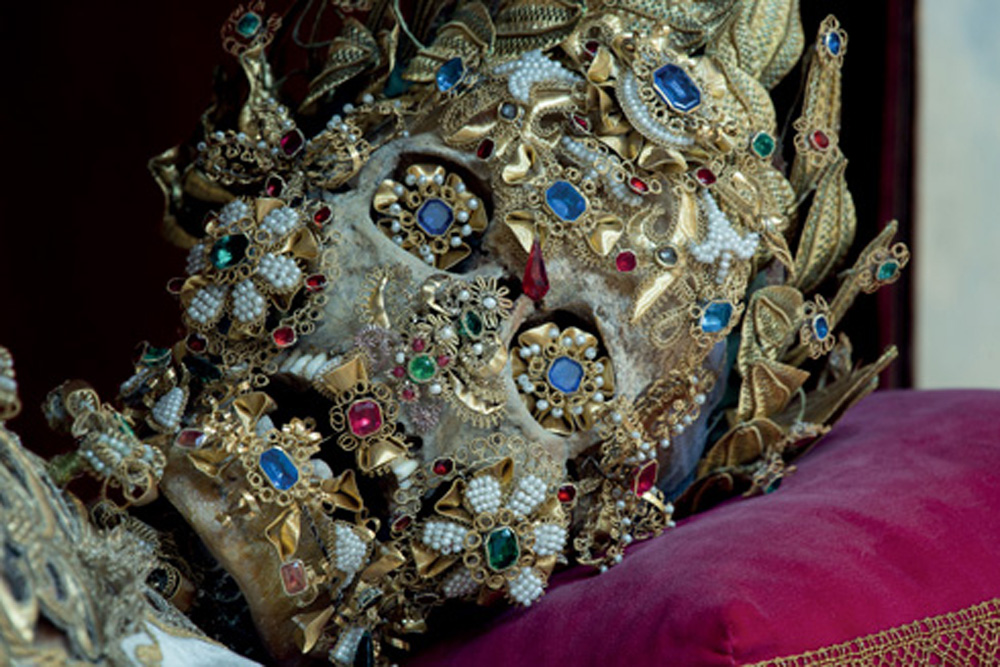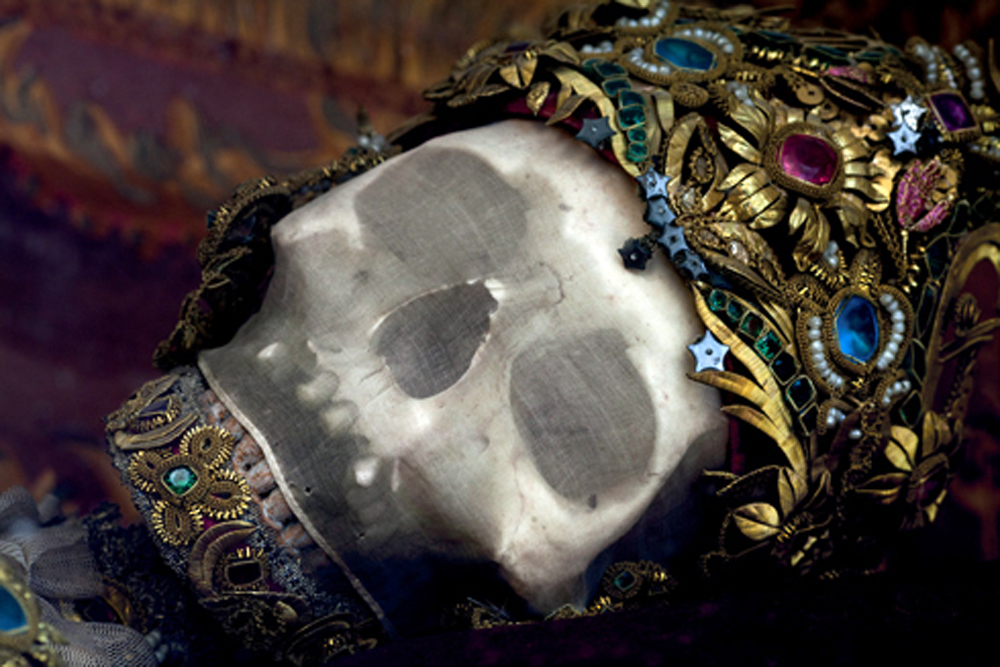
In his newly-published book Heavenly Bodies: Cult Treasures & Spectacular Saints from the Catacombs, author and photographer Paul Koudounaris brings to life a group of long-forgotten Catholic relics: the so-called Catacomb Saints, discovered in the catacombs of sixteenth-century Rome. Believed to be the bones of martyrs, many of the relics were sent to Germany to combat the growing Reformation. There the bones were intricately decorated with jewels and presented as symbols of power for the Catholic Church. Angela Serratore talked with Paul about these bejeweled skeletions.
Tell us about your discovery of the skeletons.
I first became aware of these when I was working on my book Empire of Death. The book was about charnel houses, and I was in Eastern Germany photographing a crypt of skulls when a local man came over and asked if I would be interested in seeing a full skeleton covered in jewels holding a cup of its own blood...what a question! Asking that of a guy who is going around photographing skulls is like asking a child if he wants to go to Candyland. So I told this fellow I would be very interested, and he directed me to small, apparently abandoned old chapel where one of these skeletons was still present in an altar that had been boarded over. At first I just considered it a local curiosity, but as I continued to research Empire of Death I started to come across more of them, and eventually realized this was part of a very big movement that had fallen through the cracks of visual culture and been left out of the art history books.
"Discovery" is a problematic term—many of these didn't need to be discovered, because there were a large number that were still preserved in their churches, usually in small, rural towns, the kinds of places where things don't change much.
What led sixteenth-century Catholics to decide these bones were the bones of martyrs?
The short answer is simply that they wanted to believe it. [Catholics] needed a new supply of relics during the Counter Reformation, and since these bones came from the Roman Catacombs, any of them could have conceivably come from a martyr. They looked for what they considered acceptable circumstantial evidence—an initial M, for example, might denote Martyr, although it also might be short for Marcus, the most popular name in Rome.
Are other relics decorated in this fashion, or is this something unique to the Catacomb Saints?
This style was a regional specialty. Relics had always been very fancy affairs, but there are a couple big differences between the Catacomb Saints and traditional relics. First of all, these were full skeletons—that was part of their appeal at the time, since they allowed the presentation of a full body, whereas previously a relic had usually been only a sliver or small fragment of bone. Second, previously the grand decoration had typically been confined to the reliquary itself, not the relic—in other words, the container could be very elaborate, but the bone itself was not articulated or decorated. With the Catacomb Saints, however, it was the actual relic, the sacred bones, that were decorated. But they weren't all decorated in this opulent way. My book is more about a regional style of decor than it is about Catacomb Saints in general.

Who did the decorating? What is known about the process itself?
Nuns very commonly decorated the skeletons. Sometimes monks, and the most famous decorator was a lay brother in Waldsassen, Germany, but it was most commonly nuns. Nuns had the requisite set of qualifications for such work. They had the proper temperament to work with sacred items, they had a lot of time on their hands, and they were often highly skilled artisans. We don't usually think of nuns as artists, but remember that in the convent they often specialized in certain textile and decorative arts.
There was always been a certain misogyny in the field of art history, which allowed painting and sculpture—essentially the masculine arts in which typically only men trained—to be the considered the highest of art forms. The skill set required to decorate skeletons was based more in what has been considered craft, or feminine arts—embroidery, lacework, and beading. Nuns could be incredibly skilled in those media.
The process itself was lengthy. They would start by coating the bones in an animal glue to strengthen them, then usually wrap them in a light cloth, again to protect them. Often the skeleton would not be received in its entirety, so artificial bones might have to be constructed to fill in for any that were missing, or too damaged to use.

Does the Church have an official position on the relics today? Do parishes housing the relics connect to them in the same way, or are they regarded as a kind of oddity?
There is no official position on them. To be honest, they are mostly surrounded in ignorance. The parish priests know what they are, and many of them understand that they are not real relics, but the laity tends to have no clue what their history is, other than it's the skeleton of a supposedly holy person. In a lot of cases, they are just considered curiosities of local history, or parts of a region's heritage, and of course they are certainly worthy for display and study on those grounds alone. There is only one town, Roggenburg in Germany, where a festival continues in their honor. They have four skeletons, and the relics are not normally displayed, but rather stored behind painted panels. Once a year they take them out and have a procession around the grounds of the old cloister, and then store them away again. Even in that case, the procession is more to preserve a local rite than to truly venerate the skeletons.